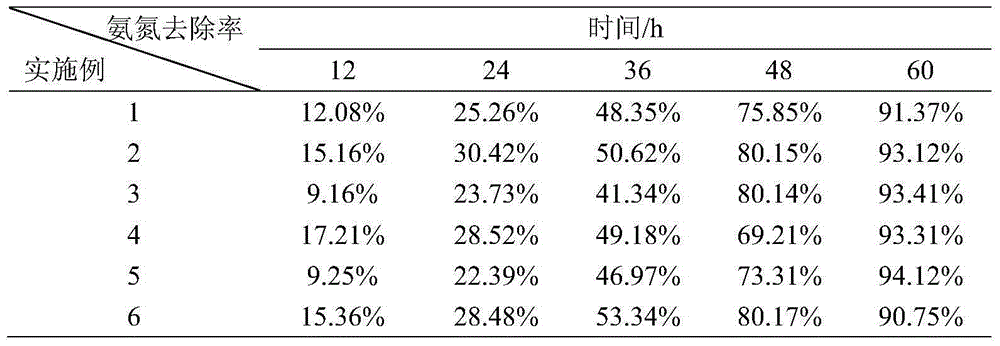Ammonia-nitrogen degrading bacterium immobilization method for treating ammonia-nitrogen wastewater
A technology for ammonia nitrogen wastewater and degrading bacteria, which is applied in chemical instruments and methods, biological water/sewage treatment, water/sludge/sewage treatment, etc. problems such as low concentration, to achieve the effect of improving stability, increasing volume load, and improving removal efficiency
- Summary
- Abstract
- Description
- Claims
- Application Information
AI Technical Summary
Problems solved by technology
Method used
Image
Examples
Embodiment 1
[0041] (1) Preparation of CaCl 2 Solution: weigh 5gCaCl 2 , dissolved in 495g of distilled water to obtain 1% CaCl 2 solution.
[0042] (2) Preparation of immobilized ammonia-nitrogen degrading bacteria granules: Add 6g polyvinyl alcohol, 2g sodium alginate and 10g particle size to 200 mesh modified sodium clinoptilolite powder in 200ml distilled water, in a 70°C water bath at 70rpm Stir continuously at a rotating speed for 1 hour to obtain a mixed homogenate. After the prepared mixed homogenate was cooled to 35° C., 10 ml of high ammonia nitrogen degrading complex bacteria was added thereto, and the stirring was continued to prepare a mixed homogenate containing ammonia nitrogen degrading bacteria. Use a 50mL syringe with a needle to draw the mixed homogenate containing ammonia nitrogen degrading bacteria, and then drop it into the CaCl with a mass fraction of 1%. 2 solution, the needle with CaCl 2 The distance between the liquid surface of the solution is 15 cm, so as t...
Embodiment 2
[0044] (1) Preparation of CaCl 2 Solution: weigh 15gCaCl 2 , dissolved in 485g of distilled water to obtain 3% CaCl 2 solution.
[0045] (2) Preparation of immobilized ammonia-nitrogen-degrading bacteria granules: add 20 g polyvinyl alcohol, 0.2 g sodium alginate and 3.3 g modified sodium clinoptilolite powder with a particle size of 325 mesh in 200 ml distilled water, and place them in a water bath at 80° C. The rotating speed of 80rpm was continuously stirred for 50min to obtain a mixed homogenate. After the mixed homogenate was cooled to 30° C., 10 ml of high ammonia nitrogen degrading complex bacteria was added thereto, and the stirring was continued to prepare a mixed homogenate containing ammonia nitrogen degrading bacteria. Use a 50mL syringe with a needle to draw the mixed homogenate containing ammonia nitrogen degrading bacteria, and then drop it into the CaCl with a mass fraction of 3%. 2 solution, the needle with CaCl 2 The distance between the liquid surface o...
Embodiment 3
[0047] (1) Preparation of CaCl 2 Solution: Weigh 50g CaCl 2 , dissolved in 450g of distilled water to obtain 10% CaCl 2 solution.
[0048] (2) Preparation of immobilized ammonia nitrogen degrading bacteria granules: add 16g polyvinyl alcohol, 0.4g sodium alginate and 5.3g modified sodium clinoptilolite powder with a particle size of 200 mesh in 200ml distilled water, and place in a water bath at 85°C with The rotating speed of 90rpm was continuously stirred for 45min to obtain a mixed homogenate. After the mixed homogenate is cooled to 32° C., add 10 ml of high ammonia nitrogen degrading complex bacteria to the solution, and continue stirring to prepare a mixed homogenate containing ammonia nitrogen degrading bacteria. Use a 50mL syringe with a needle to draw the mixed homogenate containing ammonia nitrogen degrading bacteria, and then drop it into the CaCl with a mass fraction of 10%. 2 solution, the needle with CaCl 2 The distance between the liquid surface of the solut...
PUM
| Property | Measurement | Unit |
|---|---|---|
| Granularity | aaaaa | aaaaa |
| Granularity | aaaaa | aaaaa |
| Granularity | aaaaa | aaaaa |
Abstract
Description
Claims
Application Information
 Login to View More
Login to View More - R&D
- Intellectual Property
- Life Sciences
- Materials
- Tech Scout
- Unparalleled Data Quality
- Higher Quality Content
- 60% Fewer Hallucinations
Browse by: Latest US Patents, China's latest patents, Technical Efficacy Thesaurus, Application Domain, Technology Topic, Popular Technical Reports.
© 2025 PatSnap. All rights reserved.Legal|Privacy policy|Modern Slavery Act Transparency Statement|Sitemap|About US| Contact US: help@patsnap.com

